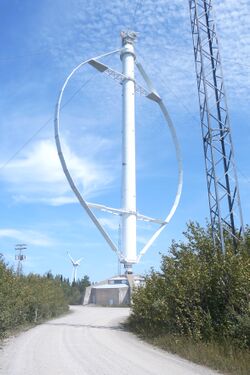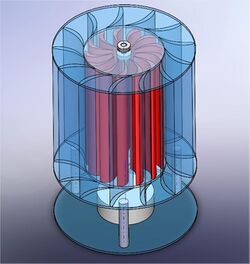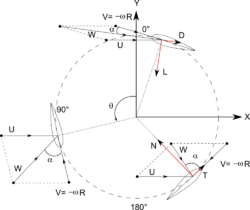Vertical axis wind turbine
Topic: Engineering
 From HandWiki - Reading time: 8 min
From HandWiki - Reading time: 8 min
A vertical-axis wind turbines (VAWT) is a type of wind turbine where the main rotor shaft is set transverse to the wind (but not necessarily vertically) while the main components are located at the base of the turbine. This arrangement allows the generator and gearbox to be located close to the ground, facilitating service and repair. VAWTs do not need to be pointed into the wind,[1][2] which removes the need for wind-sensing and orientation mechanisms. Major drawbacks for the early designs (Savonius, Darrieus and giromill) included the significant torque variation or "ripple" during each revolution, and the large bending moments on the blades. Later designs addressed the torque ripple issue by sweeping the blades helically (Gorlov type).[3]
A vertical axis wind turbine has its axis perpendicular to the wind streamlines and vertical to the ground. A more general term that includes this option is "transverse axis wind turbine" or "cross-flow wind turbine." For example, the original Darrieus patent, US Patent 1835018, includes both options.
Drag-type VAWTs such as the Savonius rotor typically operate at lower tipspeed ratios than lift-based VAWTs such as Darrieus rotors and cycloturbines.
General aerodynamics
The forces and the velocities acting in a Darrieus turbine are depicted in figure 1. The resultant velocity vector, [math]\displaystyle{ \vec{W} }[/math], is the vectorial sum of the undisturbed upstream air velocity, [math]\displaystyle{ \vec{U} }[/math], and the velocity vector of the advancing blade, [math]\displaystyle{ -\vec{\omega }\times\vec{R} }[/math].
[math]\displaystyle{ \vec{W}=\vec{U}+\left( -\vec{\omega }\times\vec{R} \right) }[/math]
File:Vertical-axis wind turbine at Hartnell College Alisal Campus.gk.webm Thus the oncoming fluid velocity varies during each cycle. Maximum velocity is found for [math]\displaystyle{ \theta =0{}^\circ }[/math] and the minimum is found for [math]\displaystyle{ \theta =180{}^\circ }[/math], where [math]\displaystyle{ \theta }[/math] is the azimuthal or orbital blade position. The angle of attack, [math]\displaystyle{ \alpha }[/math], is the angle between the oncoming air speed, W, and the blade's chord. The resultant airflow creates a varying, positive angle of attack to the blade in the upstream zone of the machine, switching sign in the downstream zone of the machine.
It follows from geometric considerations of angular velocity as seen in the accompanying figure that:
[math]\displaystyle{ V_t=R \omega + U\cos(\theta) }[/math]
and:
[math]\displaystyle{ V_n=U \sin(\theta) }[/math]
Solving for the relative velocity as the resultant of the tangential and normal components yields:
[math]\displaystyle{ W= \sqrt{V_t^2+V_n^2} }[/math] [4]
Thus, combining the above with the definitions for the tip speed ratio [math]\displaystyle{ \lambda =(\omega R) /U }[/math] yields the following expression for the resultant velocity:
[math]\displaystyle{ W=U\sqrt{1+2\lambda \cos \theta +\lambda ^{2}} }[/math] [5]
Angle of attack is solved as:
[math]\displaystyle{ \alpha = \tan^{-1} \left( \frac{V_n}{V_t} \right) }[/math]
Which when substituting the above yields:
[math]\displaystyle{ \alpha =\tan ^{-1}\left( \frac{\sin \theta }{\cos \theta +\lambda } \right) }[/math][6]
The resultant aerodynamic force is resolved either into lift (L) - drag (D) components or normal (N) - tangential (T) components. The forces are considered acting at the quarter-chord point, and the pitching moment is determined to resolve the aerodynamic forces. The aeronautical terms "lift" and "drag" refer to the forces across (lift) and along (drag) the approaching net relative airflow. The tangential force acts along the blade's velocity, pulling the blade around, and the normal force acts radially, pushing against the shaft bearings. The lift and the drag force are useful when dealing with the aerodynamic forces around the blade such as dynamic stall, boundary layer etc.; while when dealing with global performance, fatigue loads, etc., it is more convenient to have a normal-tangential frame. The lift and the drag coefficients are usually normalised by the dynamic pressure of the relative airflow, while the normal and tangential coefficients are usually normalised by the dynamic pressure of undisturbed upstream fluid velocity.
[math]\displaystyle{ C_{L}=\frac{F_L}{{1}/{2}\;\rho AW^{2}}\text{ };\text{ }C_{D}=\frac{D}{{1}/{2}\;\rho AW^{2}}\text{ };\text{ }C_{T}=\frac{T}{{1}/{2}\;\rho AU^{2}R}\text{ };\text{ }C_{N}=\frac{N}{{1}/{2}\;\rho AU^{2}} }[/math]
A = Blade Area (not to be confused with the Swept Area, which is equal to the height of the blade/rotor times the rotor diameter), R = Radius of turbine
The amount of power, P, that can be absorbed by a wind turbine:
[math]\displaystyle{ P=\frac{1}{2}C_{p}\rho A\nu^{3} }[/math]
Where [math]\displaystyle{ C_{p} }[/math] is the power coefficient, [math]\displaystyle{ \rho }[/math] is air density, [math]\displaystyle{ A }[/math] is the swept area of the turbine, and [math]\displaystyle{ \nu }[/math] is the wind speed.[7]
Advantages
VAWTs offer a number of advantages over traditional horizontal-axis wind turbines (HAWTs):
- Being omni-directional, some forms do not need to track the wind. This means they don't require a complex mechanism and motors to yaw the rotor and pitch the blades.[8]
- VAWTs generally function better than HAWTs in turbulent and gusty winds. HAWTs cannot efficiently harvest such winds, which also cause accelerated fatigue.
- the gearbox of a VAWT takes much less fatigue than that of a HAWT.[citation needed]
- In VAWTs, gearbox replacement and maintenance are simpler and more efficient, as the gearbox is accessible at ground level, so that that no cranes or other large equipment are needed on-site. This reduces costs and impact on the environment. Motor and gearbox failures generally are significant considerations in the operation and maintenance of HAWTs both on and offshore.
- some designs of VAWTs in suitable situations can use screw pile foundations, which hugely reduces the road transport of concrete and the carbon cost of installation. Screw piles can be fully recycled at the end of their life.
- wings of the Darrieus type have a constant chord and so are easier to manufacture than the blades of a HAWT, which have a much more complex shape and structure.
- VAWTs can be grouped more closely in wind farms, increasing the generated power per unit of land area.
- VAWTs can be installed on HAWT wind farm below the existing HAWTs; this can supplement the power output of the existing farm.[9]
- research at Caltech has also shown that a carefully designed wind farm using VAWTs can have an output power ten times that of a HAWT wind farm of the same size.[10]
Disadvantages
One of the major outstanding challenges facing vertical axis wind turbine technology is dynamic stall of the blades as the angle of attack varies rapidly.[11][12][13]
The blades of a VAWT are fatigue-prone due to the wide variation in applied forces during each rotation. This can be overcome by the use of modern composite materials and improvements in design - including the use of aerodynamic wing tips that cause the spreader wing connections to have a static load. The vertically oriented blades can twist and bend during each turn, causing them to break apart.
VAWTs have proven less reliable than HAWTs,[14] although modern designs of VAWTs have overcome many of the issues associated with early designs.[15][16]
Applications
The Windspire, a small VAWT intended for individual (home or office) use was developed in the early 2000s by US company Mariah Power. The company reported that several units had been installed across the US by June 2008.[17]
Arborwind, an Ann-Arbor (Michigan, US) based company, produces a patented small VAWT which has been installed at several US locations as of 2013.[18]
In 2011, Sandia National Laboratories wind-energy researchers began a five-year study of applying VAWT design technology to offshore wind farms.[19] The researchers stated: "The economics of offshore windpower are different from land-based turbines, due to installation and operational challenges. VAWTs offer three big advantages that could reduce the cost of wind energy: a lower turbine center of gravity; reduced machine complexity; and better scalability to very large sizes. A lower center of gravity means improved stability afloat and lower gravitational fatigue loads. Additionally, the drivetrain on a VAWT is at or near the surface, potentially making maintenance easier and less time-consuming. Fewer parts, lower fatigue loads and simpler maintenance all lead to reduced maintenance costs."
A 24-unit VAWT demonstration plot was installed in southern California in the early 2010s by Caltech aeronautical professor John Dabiri. His design was incorporated in a 10-unit generating farm installed in 2013 in the Alaskan village of Igiugig.[20]
Dulas, Anglesey received permission in March 2014 to install a prototype VAWT on the breakwater at Port Talbot waterside. The turbine is a new design, supplied by Wales-based C-FEC (Swansea),[21] and will be operated for a two-year trial.[22] This VAWT incorporates a wind shield which blocks the wind from the advancing blades, and thus requires a wind-direction sensor and a positioning mechanism, as opposed to the "egg-beater" types of VAWTs discussed above.[21]
4 Navitas (Blackpool) have been operating two prototype VAWTs since June 2013, powered by a Siemens Power Train, they are due to enter the market in January 2015, with a free technology share to interested parties. 4 Navitas are now in the process of scaling their prototype to 1 MW, (working with PERA Technology) and then floating the turbine on an offshore pontoon. This will reduce the cost of offshore wind energy. [citation needed]
The Dynasphere, is Michael Reynolds' (known for his Earthship house designs) 4th generation vertical axis windmill. These windmills have two 1.5 KW generators and can produce electricity at very low speeds.[23]
See also
- Horizontal axis wind turbine
- Unconventional wind turbines
References
- ↑ Jha, A.R. (2010). Wind turbine technology. Boca Raton, FL: CRC Press.[page needed]
- ↑ Raciti Castelli, Marco; Englaro, Alessandro; Benini, Ernesto (2011). "The Darrieus wind turbine: Proposal for a new performance prediction model based on CFD". Energy 36 (8): 4919–34. doi:10.1016/j.energy.2011.05.036.
- ↑ Analysis of Different Blade Architectures on small VAWT Performance
- ↑ Islam, M; Ting, D; Fartaj, A (2008). "Aerodynamic models for Darrieus-type straight-bladed vertical axis wind turbines". Renewable and Sustainable Energy Reviews 12 (4): 1087–109. doi:10.1016/j.rser.2006.10.023.
- ↑ https://fenix.tecnico.ulisboa.pt/downloadFile/395143097660/Extended%20abstract.pdf[full citation needed]
- ↑ El Kasmi, Amina; Masson, Christian (2008). "An extended k–ε model for turbulent flow through horizontal-axis wind turbines". Journal of Wind Engineering and Industrial Aerodynamics 96: 103–22. doi:10.1016/j.jweia.2007.03.007.
- ↑ Eriksson, S; Bernhoff, H; Leijon, M (2008). "Evaluation of different turbine concepts for wind power". Renewable and Sustainable Energy Reviews 12 (5): 1419–34. doi:10.1016/j.rser.2006.05.017.
- ↑ AIP Conference Proceedings 1931, 030040 (2018); [1]
- ↑ Peace, Steven (June 1, 2004). "Another Approach to Wind". Mechanical Engineering. https://www.highbeam.com/doc/1P3-648721101.html.
- ↑ Svitil, Kathy (July 13, 2011). "Wind-turbine placement produces tenfold power increase, researchers say". PhysOrg. http://phys.org/news/2011-07-wind-turbine-placement-tenfold-power.html.
- ↑ Buchner, A-J.; Soria, J.; Honnery, D.; Smits, A.J. (2018). "Dynamic stall in vertical axis wind turbines: Scaling and topological considerations". Journal of Fluid Mechanics 841: 746–66. doi:10.1017/jfm.2018.112. Bibcode: 2018JFM...841..746B.
- ↑ Buchner, A-J.; Lohry, M.W.; Martinelli, L.; Soria, J.; Smits, A.J. (2015). "Dynamic stall in vertical axis wind turbines: Comparing experiments and computations". Journal of Wind Engineering and Industrial Aerodynamics 146: 163–71. doi:10.1016/j.jweia.2015.09.001.
- ↑ Simão Ferreira, Carlos; Van Kuik, Gijs; Van Bussel, Gerard; Scarano, Fulvio (2008). "Visualization by PIV of dynamic stall on a vertical axis wind turbine". Experiments in Fluids 46: 97–108. doi:10.1007/s00348-008-0543-z. Bibcode: 2009ExFl...46...97S.
- ↑ Chiras, Dan (2010). Wind Power Basics: A Green Energy Guide. New Society. ISBN 978-0-86571-617-9.[page needed]
- ↑ Ashwill, Thomas D.; Sutherland, Herbert J.; Berg, Dale E. (2012). A retrospective of VAWT technology. doi:10.2172/1035336. https://digital.library.unt.edu/ark:/67531/metadc846454/.
- ↑ Kear, Matt; Evans, Ben; Ellis, Rob; Rolland, Sam (January 2016). "Computational aerodynamic optimisation of vertical axis wind turbine blades". Applied Mathematical Modelling 40 (2): 1038–1051. doi:10.1016/j.apm.2015.07.001. ISSN 0307-904X. https://cronfa.swan.ac.uk/Record/cronfa22343.
- ↑ LaMonica, Martin (2 June 2008). "Vertical-axis wind turbine spins into business". CNET. http://www.cnet.com/news/vertical-axis-wind-turbine-spins-into-business/. Retrieved 18 September 2015.
- ↑ "History". Arbor Wind. http://www.arborwind.com/about-us/history/. Retrieved 18 September 2015.
- ↑ Holinka, Stephanie (8 August 2012). "Offshore Use of Vertical-axis Wind Turbines Gets Closer Look". Renewable Energy World. http://www.renewableenergyworld.com/articles/2012/08/offshore-use-of-vertical-axis-wind-turbines-gets-closer-look.html. Retrieved 18 September 2015.
- ↑ Bullis, Kevin (8 April 2013). "Will Vertical Turbines Make More of the Wind?". MIT Technology Review. http://www.technologyreview.com/news/513266/will-vertical-turbines-make-more-of-the-wind/. Retrieved 18 September 2015.
- ↑ 21.0 21.1 "C-Fec turbine". C-Fec. http://www.c-fec.com/turbine/. Retrieved 18 September 2015.
- ↑ "Dulas secures consent for prototype 'vertical axis' wind turbine". Renewable Energy Focus. 5 March 2014. http://www.renewableenergyfocus.com/view/37298/dulas-secures-consent-for-prototype-vertical-axis-wind-turbine/. Retrieved 18 September 2015.
- ↑ "Vertical Axis Wind Power Generation Prototype". Earthship Biotecture. http://earthship.com/vertical-axis-wind-power-generation-prototype. Retrieved 18 September 2015.
External links
- Cellar Image of the Day Shows a VAWT transverse to the wind, yet with the axis horizontal, but such does not allow the machine to be called a HAWT.
 KSF
KSF



